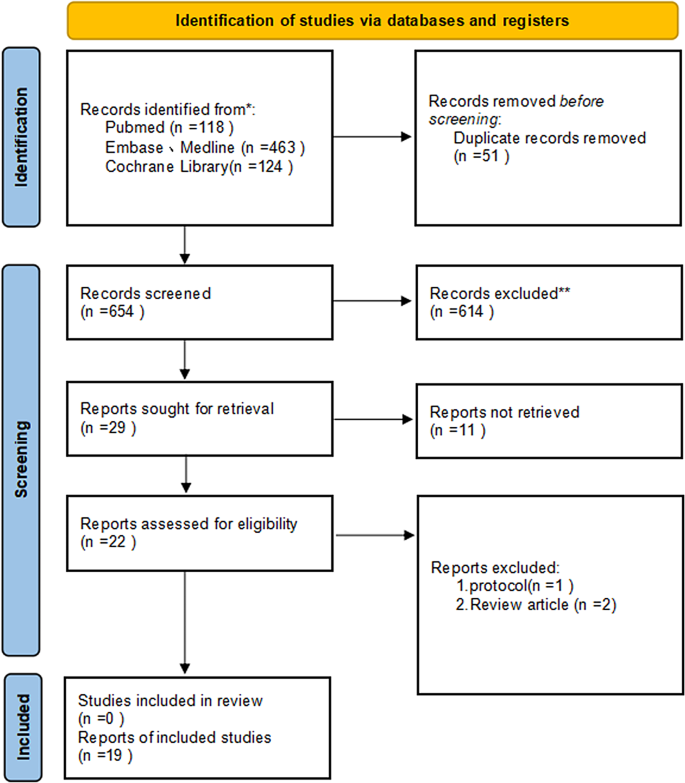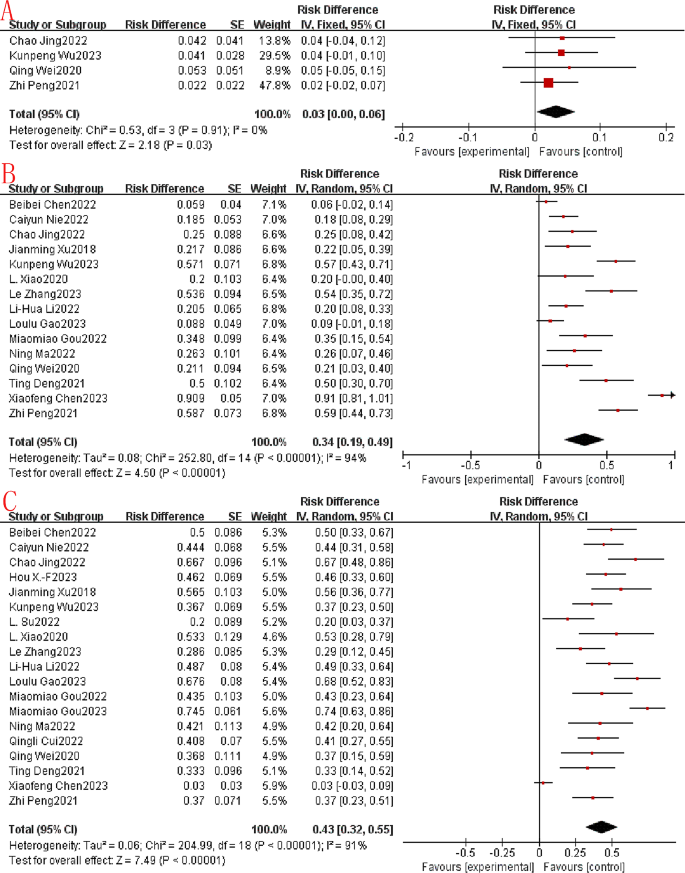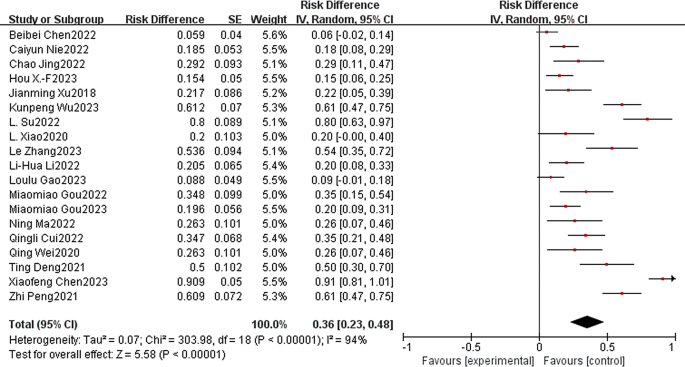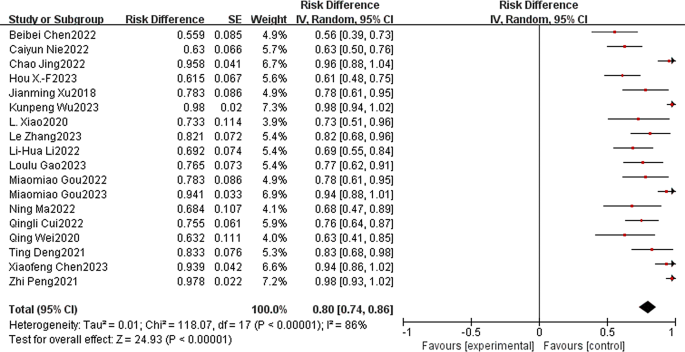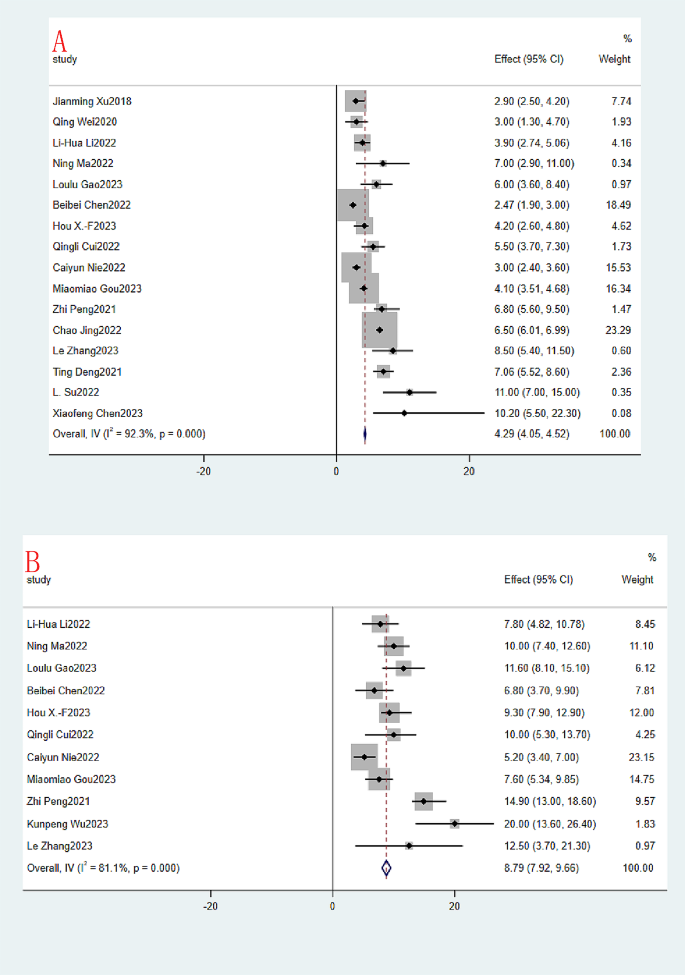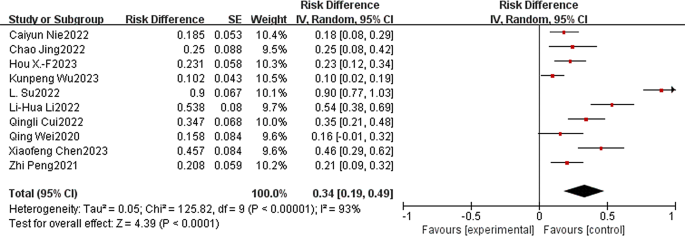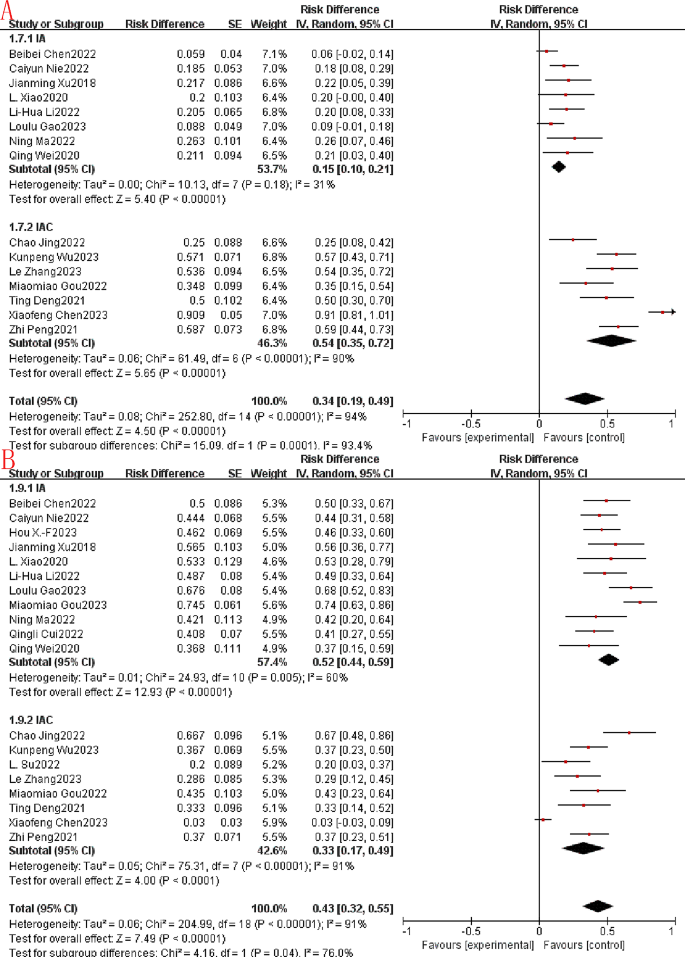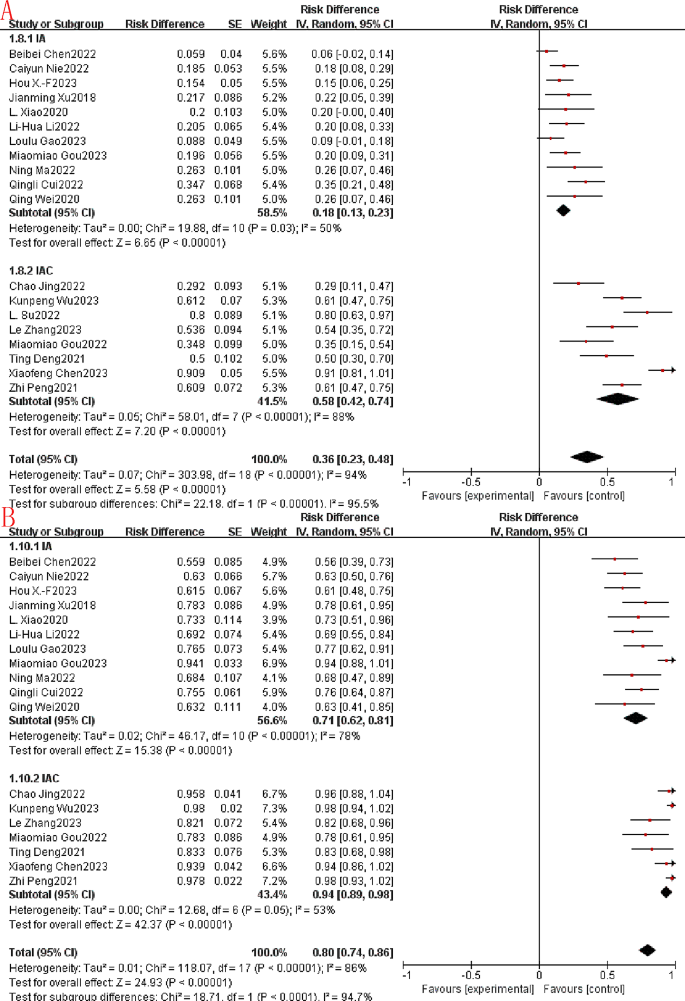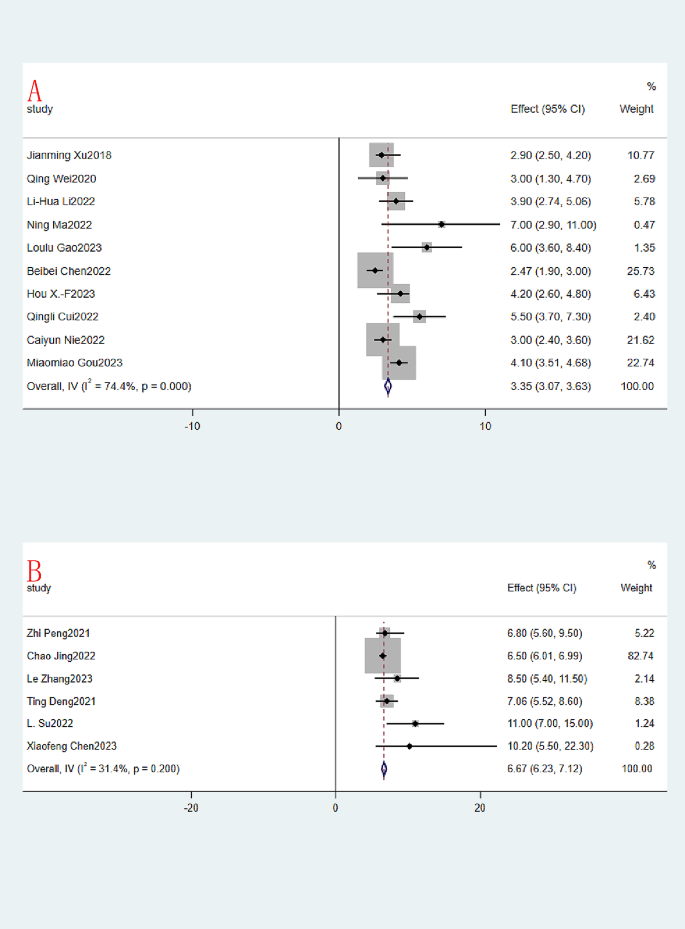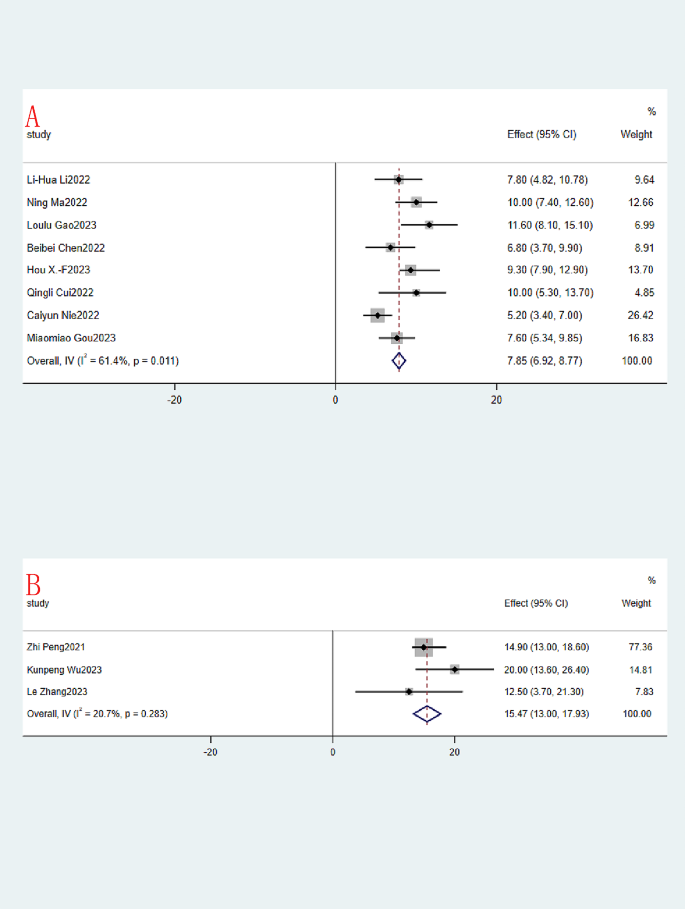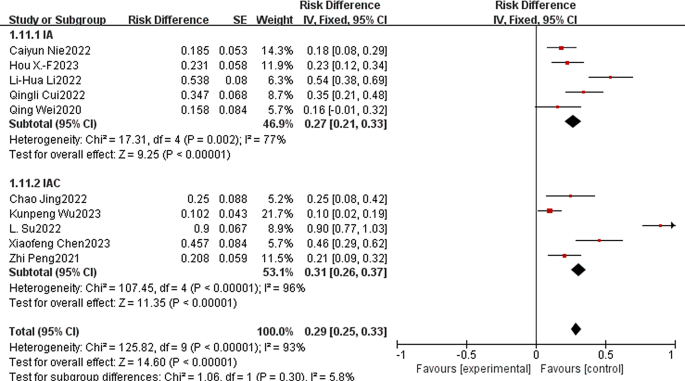- Systematic Review
- Open access
- Published:
Immunotherapy combined with apatinib in the treatment of advanced or metastatic gastric/gastroesophageal tumors: a systematic review and meta-analysis
BMC Cancer volume 24, Article number: 603 (2024)
Abstract
Background
Immunotherapy or apatinib alone has been used as third-line adjuvant therapy for advanced or metastatic gastric/gastroesophageal junction (G/GEJ) tumors, but the efficacy of combining them with each other for the treatment of patients with advanced or metastatic G/GEJ is unknown; therefore, we further evaluated the efficacy and safety of immunotherapy combined with apatinib in patients with advanced or metastatic G/GEJ.
Methods
The main search was conducted on published databases: Embase, Cochrane library, PubMed.The search was conducted from the establishment of the database to December 2023.Clinical trials with patients with advanced or metastatic G/GEJ and immunotherapy combined with apatinib as the study variable were collected. Review Manager 5.4 software as well as stata 15.0 software were used for meta-analysis.
Results
A total of 651 patients from 19 articles were included in this meta-analysis. In the included studies, immunotherapy combined with apatinib had a complete response (CR) of 0.03 (95% CI: 0.00 -0.06), partial response (PR) of 0.34 (95% CI: 0.19–0.49), stable disease (SD) of 0.43 (95% CI: 0.32–0.55), objective response rate (ORR) was 0.36 (95% CI: 0.23–0.48), disease control rate (DCR) was 0.80 (95% CI: 0.74–0.86), and median progression-free survival (PFS) was 4.29 (95% CI: 4.05–4.52), median Overall survival (OS) was 8.79 (95% CI: 7.92–9.66), and the incidence of grade ≥ 3 TRAEs was 0.34 (95% CI: 0:19-0.49). PR, ORR, DCR, median PFS and median OS were significantly higher in the immunotherapy and apatinib combination chemotherapy group (IAC) than in the immunotherapy combination apatinib group (IA). And the difference was not significant in the incidence of SD and grade ≥ 3 TRAEs.
Conclusion
This meta-analysis shows that immunotherapy combined with apatinib is safe and effective in the treatment of advanced or metastatic G/GEJ, where IAC can be a recommended adjuvant treatment option for patients with advanced or metastatic G/GEJ. However, more large multicenter randomized studies are urgently needed to reveal the long-term outcomes of immunotherapy combined with apatinib treatment.
Introduction
Gastric or gastroesophageal junction (G/GEJ) tumors are a common malignancy with a rather poor prognosis, which ranks as the fifth most common malignancy and the third leading cause of cancer deaths, and the majority of cases are diagnosed at an advanced stage [1, 2]. With respect to advanced or metastatic G/GEJ adenocarcinomas that do not express HER2, fluoropyrimidine plus platinum-based systemic chemotherapy regimens remain the mainstay of first-line treatment [3]. The second-line treatment of advanced gastric cancer with paclitaxel, irinotecan, doxorubicin, or combination paclitaxel. The Chinese Society of Clinical Oncology (CSCO) guidelines for third-line treatment recommend the use of apatinib, nivulizumab, pembrolizumab, or a rational choice of chemotherapy regimen with reference to the second-line recommended modality [4]. Nevertheless, there are study data suggesting objective remission rates (ORR) of 6.8–25% and progression-free survival (PFS) of 1.5–5.3 months in second or second-line therapy [5,6,7]. At the same time, with the development of the patient’s condition, the drug resistance of conventional chemotherapy drugs gradually increased, and the clinical application effect decreased significantly [8]. There is an urgent need to develop more effective therapeutic options for the follow-up of patients with advanced or metastatic G/GEJ.
With the emergence of checkpoint inhibitors has led to fundamental changes in the treatment of a number of tumors. Anti-programmed death-1 (anti -programmed death-1,PD-1) antibodies and their ligand, PD-L1 antibodies, have shown antitumor efficacy in a variety of cancers, of which, pembrolizumab has been approved as a third-line treatment for PD-L1-expressing advanced GC [9]. On the other hand, only about 10% of patients with advanced GC/ GEJ benefit from monotherapy [10, 11]. A number of studies have revealed that combining immunotherapy with other treatments could produce a substantial impact on patients with advanced cancer [12,13,14]. There has been much interest in recent years in the efficacy of anti-pd -1 combined with molecular antiangiogenic drugs. Antiangiogenesis is an established tumor microenvironment (TME)-targeted therapy for GC/GEJ. It may be possible to overcome primary resistance in patients with advanced GC/GEJ by combining PD-1/PD-L1 blockade with agents capable of eliminating pre-existing immunosuppression in the TME [15,16,17]. Recent studies of the selective VEGFR1-3 inhibitor axitinib in combination with pembrolizumab for the treatment of patients with advanced renal cell carcinoma have reported promising antitumor activity and an acceptable safety profile [18]. Another study of the combination of an anti-pd - l1 antibody (atezolizumab) and a vegf antibody (bevacizumab) also showed encouraging response rates in patients with advanced HCC who tolerated the toxicity [19].
Apatinib is a selective VEGFR2 TKI approved for the treatment of advanced gastric cancer in China [20]. A potential additive or synergistic anti-tumor effect between anti-pd-1 antibodies and VEGF/VEGFR2 inhibitors as demonstrated in vitro and phase I clinical studies [21, 22]. The aim of this meta-analysis is to demonstrate the efficacy and safety of immunotherapy in combination with apatinib in the treatment of advanced or metastatic G/GEJ based on the available data, and to provide further therapeutic options for better survival benefit in advanced or metastatic G/GEJ in the future. Until now, there is no published meta-analysis on a similar topic.
Methods
Data sources and search strategy
We conducted an independent systematic literature search mainly in PubMed, Embase, Cochrane Library and Web of Science databases. Recent unpublished clinical trials of immunotherapy combined with apatinib for advanced or metastatic G/GEJ tumors from the American Society of Clinical Oncology (ASCO), the European Society for Medical Oncology (ESMO), and other international oncology congresses were included. The time span was from the inception of the database to December 1, 2023. All keywords were searched by MeSH, mainly including “immunologic agents”, “apatinib”, “advanced or metastatic”, " gastric cancer” and “gastroesophageal junction tumor”. This systematic evaluation and meta-analysis followed the Preferred Reporting Items for Systematic Evaluation and Meta-Analysis (PRISMA) statement [23]. The systematic evaluation and meta-analysis is registered with PROSPERO (registration number: CRD42023491167).
Inclusion and exclusion criteria
In this meta-analysis, the inclusion criteria were as follows: (1) patients with histopathologically confirmed advanced or metastatic G/GEJ; (2) immunotherapy combined with apatinib as the primary therapeutic agent; and (3) reported at least one of the following primary outcomes: incidence of CR, PR, SD, ORR, DCR, median PFS, median OS, and ≥ 3TRAEs. Exclusion criteria were as follows: (1) patients with resectable or locally advanced G/GEJ; (2) case reports, reviews, or commentaries; (3) multiple articles published by different authors with overlapping or duplicated data; (4) articles not in English; and (5) studies that did not address the key findings of the current meta-analysis.
Data extraction and quality assessment
Two authors (JCW and JL) independently filtered the titles and abstracts of all included studies. The abstracts of all potentially eligible trials were read independently by the same authors who decided whether the study was selected. The full text of all selected papers was then analyzed by the same author to select all trials that were ultimately included in the combined analysis. When discrepancies in trial search or selection arose, they were discussed with a third researcher (RMW) to reach a final consensus. Data were recorded and archived in an Excel spreadsheet. In addition, parameters were extracted in a uniform format, including first author, year of publication, study type (single-arm or RCT), approval number, dMMR/pMMR, HER2, PD-L1 expression, pathologic typing, pathologic staging, treatment modality, number of enrollees, age, incidence of ≥ grade 3 TRAEs, CR, PR, ORR, SD, DCR, median PFS, and median OS. The partial MINORS tool was used to evaluate the study quality. The items are scored 0 (not reported), 1 (reported but inadequate), or 2 (reported and adequate) [24].
Statistical analysis
Meta-analysis of non-comparative binary outcomes was mainly applied because most of the included studies were single-arm clinical studies and the outcome indicators were mainly expressed as proportions. The combined odds ratios (OR) and 95% confidence intervals (CI) were converted into incidence rates to assess the efficacy and safety of immunotherapy in combination with apatinib in the treatment of advanced/metastatic G/GEJ. q-tests of P < 0.05 or I2 > 50% were used to consider that there was significant heterogeneity in the literature, and a random-effects model was used; otherwise, a fixed-effects model was applied. In addition, sensitivity analyses were performed by sequentially removing individual studies to assess the stability of the combined results of these studies. For studies with significant heterogeneity that could not be reduced using sensitivity analyses, further subgroup analyses were performed to explore the sources of heterogeneity. A funnel plot test for publication bias was used. p < 0.05 was considered a statistically significant difference. In addition, as median PFS and median OS were continuous variables that could not be calculated using incidence for analysis, further analysis using stata 15.0 software was required. All analyses were performed using Review Manager 5.4/stata 15.0 software.
Results
The characteristics of the included studies
There is a PRISMA diagram of the study selection process as shown in Fig. 1. According to the search strategy, a total of 705 publications were included (118 PubMed, 463 Embase, and 124 Web of science), and 19 studies [21, 25,26,27,28,29,30,31,32,33,34,35,36,37,38,39,40,41,42] with a total of 651 patients were eligible for inclusion in the final meta-analysis. meta-analysis included a total of 16 single-arm cohort studies, and three randomized controlled studies. The main immunotherapeutic agents were SHR-1210, JS001, Camrelizumab, Pembrolizumab, sintilmab, Tislelizumab, and Nivolumab.Depending on the treatment regimen, we can categorize them into 2 main therapeutic modalities, namely, immunotherapy combined with apatinib (IA) and immunotherapy and apatinib combined with chemotherapy (IAC). The main characteristics of the included studies are shown in Table 1, and the main outcomes are shown in Table 2. Supplementary Table 1 shows the overall low risk of bias of the included studies.
Evaluation of efficacy outcomes
In this study, CR, PR, SD, ORR and DCR were used to evaluate the efficacy of immunoapatinib treatment. CR is when a tumor has been treated so that all previously detectable tumors have disappeared and there is no clinical or imaging evidence of tumor presence. Of all the included studies, CR was not assessed in 4 studies, CR was not achieved in 11 studies, and CR in the remaining studies ranged from 2.2 to 5.3%. In the four eligible studies, the combined CR was 0.03 (95% CI: 0.00 -0.06), a statistically significant difference (p = 0.03). Using a fixed-effects model, there was no significant heterogeneity among the 4 studies (P = 0.91, I2 = 0%; Fig. 2A). PR was defined as a ≥ 30% reduction in the sum of the largest diameters of the tumor target lesions, maintained for at least 4 weeks. Meanwhile, among the 15 eligible studies, the combined PR was 0.34 (95% CI: 0.19–0.49), a statistically significant difference (P < 0.00001). Using a random-effects model, there was significant heterogeneity among the 15 studies (p < 0.00001, I2 = 94%; Fig. 2B). SD is defined as shrinkage of the sum of the largest diameters of the tumor target lesions without PR, or enlargement without disease progression. Among the 19 eligible studies, the combined SD was 0.43 (95% CI: 0.32–0.55), a statistically significant difference (p < 0.00001). Using a random-effects model, there was similarly significant heterogeneity among the 15 studies (p < 0.00001, I2 = 91%; Fig. 2C).
ORR is the proportion of patients whose tumor volume shrinks to a pre-specified value and maintains the minimum timeframe requirement, and is the sum of the CR and PR proportions. In addition, the 19 included studies reported ORR rates ranging from 5.9 to 90.9%. The joint ORR was 0.36 (95% CI: 0.23–0.48), a statistically significant difference (p < 0.0001). Using a random-effects model, there was significant heterogeneity among the 19 studies (p < 0.0001, I2 = 94%; Fig. 3). DCR is the number of cases that achieved remission (PR + CR) and lesion stabilization (SD) after treatment as a percentage of the number of evaluable cases. In contrast, a total of 18 studies could be included in the DCR for single-arm Meta-analysis, with a joint DCR of 0.80 (95% CI: 0.74–0.86), a statistically significant difference (p < 0.0001). Using a random-effects model, there was similarly significant heterogeneity among the 18 studies (p < 0.0001, I2 = 86%; Fig. 4).
The same was true for median PFS and median OS, with 16 and 11 studies included, respectively. The median PFS (month) ranged from 2.47 to 11, and the OR of the combined median PFS was 4.29 (95% CI:4.05–4.52, I2 = 92.3%,P = 0.000, Fig. 5A). Due to the large heterogeneity of the 16 studies, a random effects model was used. The median OS (month) of course also ranged from 5.2 to 20, and the OR of the combined median OS was 8.79 (95% CI:7.92–9.66, I2 = 81.1%,P = 0.000, Fig. 5B). Again, due to the large heterogeneity of the 11 included studies, a random effects model was used.
Evaluation of safety outcomes
The safety of immunotherapy in combination with apatinib for the treatment of patients with advanced or metastatic G/GEJ was evaluated according to the National Cancer Institute Common Terminology Criteria for Adverse Events (NCI-CTCAE16; version 4.0) [43]. A total of 10 of the included clinical studies reported the incidence of grade ≥ 3 and higher treatments, totaling 118 patients. The incidence of combined grade ≥ 3 TRAEs was 0.34 (95% CI: 0:19-0.49, I2 = 93%, P < 0.00001) (Fig. 6). Only 1 patient [35] patient died due to grade ≥ 3 TRAEs (abnormal liver function and interstitial lung disease). Other mainly controllable adverse events such as thrombocytopenia, anemia, neutropenia, leukopenia, pruritus, rash, hand-foot syndrome, elevated AST/ALT, fatigue, nausea and vomiting, diarrhea, hypertension, proteinuria, and reactive cutaneous capillary endothelial cell proliferation, among others, did not result in serious adverse outcomes or lead to mortality.
Sensitivity analysis and subgroup analysis
Reconsideration of study search, selection, and inclusion criteria did not reduce heterogeneity. To determine that the joint results were not heavily influenced by individual trials, the included studies were taken out of sequence for sensitivity analysis. We found that this did not significantly reduce heterogeneity. To further identify possible sources of heterogeneity, immunotherapy combined with apatinib was grouped according to whether it was combined with other treatment modalities. In the subgroup analysis, significant differences in PR, SD, ORR, DCR, median PFS and median OS were found. Among them, PR, ORR, DCR, median PFS and median OS were much higher in the IAC group than in the IA group (0.54 vs. 0.15, Fig. 7A.58 vs. 0.18, Fig. 8A.94 vs. 0.71, Fig. 8B.67 vs. 3.35, Fig. 9.85 vs. 15.79, Fig. 10). In terms of the incidence of SD, the IAC group group was slightly lower than the IA group, but the difference was not significant (0.33 vs. 0.52, Fig. 7B). And there was no significant difference between the IAC group and the IA group in terms of grade ≥ 3 TRAEs (0.31 vs. 0.27, I2 = 5.8%,P = 0.30, Fig. 11). This showed that the IAC group both improved the effectiveness of the treatment without increasing the incidence of adverse events, implying that the combination of immunotherapy and apatinib with chemotherapy may be somehow superior to immunotherapy alone combined with apatinib.
Publication bias
Due to the high degree of heterogeneity, most of the above results were obtained using random-effects models, and therefore future phase 3 and large-scale randomized controlled trials are needed for further assessment. Funnel plots were used to analyze possible publication bias for immunotherapy combined with apatinib in 19 clinical studies. Most of the data collected were single-arm clinical trials without controls, but there was no significant publication bias (Supplementary Fig. 1).
Discussion
Approximately half of the world’s new cases of gastric cancer are detected in China each year, and half of all Chinese patients are diagnosed at an advanced stage. It is recommended in the 2021 CSCO guidelines that fluorouracil in combination with platinum (or) paclitaxel is the first-line standard chemotherapy regimen for patients with her2 negative advanced gastric cancer [4]. But in clinical practice, there are still a large number of patients failing first-line treatment. As a maintenance or sequential treatment chemo-free strategy is constantly being explored. Immunotherapy or apatinib alone has been used in the third-line treatment of advanced or metastatic G/GEJ, but the results remain suboptimal. Regardless of PD-L1 status in the ATTRACTION-2 trial, nivolumab monotherapy improved overall survival in patients with advanced gastric cancer by 5.26 months (95% CI 4.60–6.37), but the ORR was only 11.2% (95% CI: 7.77–15.6) [10]. Based on previous studies, the median PFS and OS of mGC patients receiving third-line treatment with apatinib monotherapy were 2.70 ∼ 4.47 months and 4.27–6.51 months, respectively [20, 44, 45]. Some findings suggest that combination therapy with PD-1 inhibitors and apatinib improves therapeutic efficacy, mainly because tumor angiogenesis inhibits the extravasation of reactive T-cells, which form an immunosuppressive microenvironment, leading to tumor evasion of immune surveillance. Combination therapy enhances t-cell infiltration and activation, thereby eliminating tumor cells [46,47,48,49]. A combination study of PD-1 monoclonal antibodies and angiogenesis inhibitors has been initially validated in several clinical trials. Ramucirumab in combination with nivolumab or pembrolizumab has shown promising efficacy in AGC patients in several phase I/II trials [50,51,52].
As far as we know, this is the first meta-analysis evaluating the efficacy and safety of immunotherapy combined with apatinib for the treatment of patients with advanced or metastatic G/GEJ. Our analysis is based on 19 small studies, including 651 patients, quantitatively and synthetically analyzing the efficacy and safety of immunotherapy combined with apatinib treatment. There is great excitement about the results of the current meta-analysis study. The aggregated CR, PR, SD, ORR and DCR for immunotherapy combined with apatinib were 0.03 (95% CI: 0.00 -0.06), 0.34 (95% CI: 0.19–0.49), 0.43 (95% CI: 0.32–0.55), 0.36 (95% CI: 0.23–0.48), 0.80 (95% CI: 0:74-0.86). And the median PFS and median OS reached 4.29 (95% CI:4.05–4.52), 8.79 (95% CI:7.92–9.66), respectively. Subgroup analysis showed significant differences in PR, ORR, DCR, median PFS, and median OS, with the IAC group being significantly better than the IA group as well as the IAC group being slightly lower than the IA group in terms of SD. The IAC group had an ORR of 0.58 (95% CI: 0.42–0.74, Fig. 8A), a DCR of 0.94 (95% CI: 0.89–0.98, Fig. 8B) a median PFS of 6.67 months (95% CI: 6.23–7.12, Fig. 9B) and a median OS of 15.47 months (95% CI. 13.00-17.93, Fig. 10B), which was higher than the ORR (about 40%), PFS (5.5 months) and OS (11.5 months) of fluorouracil-platinum regimen [53]. This suggests that combination chemotherapy with immunotherapy and apatinib is superior to adjuvant chemotherapy in terms of effectiveness. In the IAC group, the L. Su et al. study achieved a 100% DCR as well as the highest median PFS of 11.0 (95% CI: 7.0–15.0) months [41]. In addition, there was the highest median OS of 20.0 months (95% CI: 13.6–26.4) in the study by Kunpeng Wu et al [37]. And from the 3 RCT trials we included, we found that immunotherapy combined with apatinib treatment was superior to immuno/apatinib alone, apatinib combined with chemotherapy, and immuno combined with chemotherapy in terms of median PFS and median OS [32,33,34].
Considering the safety of immunotherapy combined with apatinib, the combined OR for the incidence of grade ≥ 3 TRAEs was 0.34 (95% CI: 0:19-0.49), which was not significantly different between the IAC and IA groups (0.31 vs. 0.27). Among the studies we included, only 2 studies explicitly stated that a total of 6 and 12 patients, respectively, discontinued their medication because of TRAE due to immunologic agents or apatinib [26, 36]. Only one patient also died from grade ≥ 3 TRAEs, and other adverse events were manageable. In conclusion, combination therapy with immunotherapy and apatinib has shown encouraging clinical activity in patients with advanced or metastatic G/GEJ, which may improve survival and show tolerable toxicity as second- or third-line therapy.
On the other hand, however, the current meta-analysis still has some limitations. First, the small number of included studies, insufficient sample size, and mostly single-arm clinical trials, the lack of randomized controlled trials, and the single type of study may lead to bias. Therefore, more multicenter, large-sample phase III randomized controlled trials and subsequent meta-analysis are needed to further validate the results of this study. Second, more predictive biomarkers are urgently needed to identify patients who benefit most from immunotherapy combined with apatinib treatment. Despite the heterogeneity, the results suggest that adjuvant therapy based on immunotherapy combined with apatinib is safe and feasible with a favorable improvement in survival, pointing the way to the future development of adjuvant therapy for advanced or metastatic G/GEJ.
Conclusion
This meta-analysis shows that immunotherapy combined with apatinib is safe and effective in the treatment of advanced or metastatic G/GEJ, where IAC can be a recommended adjuvant treatment option for patients with advanced or metastatic G/GEJ. However, more large multicenter randomized studies are urgently needed to reveal the long-term outcomes of immunotherapy combined with apatinib treatment.
Data availability
The original contributions presented in the study are included in the article/Supplementary Material. Further inquiries can be directed to the corresponding author.
References
Ferlay J, Soerjomataram I, Dikshit R, Eser S, Mathers C, Rebelo M, Parkin DM, Forman D, Bray F. Cancer incidence and mortality worldwide: sources, methods and major patterns in GLOBOCAN 2012. Int J Cancer. 2015;136(5):E359–386.
Catalano V, Labianca R, Beretta GD, Gatta G, de Braud F, Van Cutsem E. Gastric cancer. Crit Rev Oncol Hematol. 2009;71(2):127–64.
Wagner AD, Syn NL, Moehler M, Grothe W, Yong WP, Tai BC, Ho J, Unverzagt S. Chemotherapy for advanced gastric cancer. Cochrane Database Syst Rev. 2017;8(8):Cd004064.
Wang FH, Zhang XT, Li YF, Tang L, Qu XJ, Ying JE, Zhang J, Sun LY, Lin RB, Qiu H et al. The Chinese Society of Clinical Oncology (CSCO): clinical guidelines for the diagnosis and treatment of gastric cancer, 2021. Cancer communications (London, England) 2021, 41(8):747–95.
Chan WL, Yuen KK, Siu SW, Lam KO, Kwong DL. Third-line systemic treatment versus best supportive care for advanced/metastatic gastric cancer: a systematic review and meta-analysis. Crit Rev Oncol Hematol. 2017;116:68–81.
Galdy S, Cella CA, Spada F, Murgioni S, Frezza AM, Ravenda SP, Zampino MG, Fazio N. Systemic therapy beyond first-line in advanced gastric cancer: an overview of the main randomized clinical trials. Crit Rev Oncol Hematol. 2016;99:1–12.
Takahari D. Second-line chemotherapy for patients with advanced gastric cancer. Gastric Cancer. 2017;20(3):395–406.
Shitara K, Takashima A, Fujitani K, Koeda K, Hara H, Nakayama N, Hironaka S, Nishikawa K, Makari Y, Amagai K, et al. Nab-paclitaxel versus solvent-based paclitaxel in patients with previously treated advanced gastric cancer (ABSOLUTE): an open-label, randomised, non-inferiority, phase 3 trial. Lancet Gastroenterol Hepatol. 2017;2(4):277–87.
Fuchs CS, Doi T, Jang RW, Muro K, Satoh T, Machado M, Sun W, Jalal SI, Shah MA, Metges JP, et al. Safety and Efficacy of Pembrolizumab Monotherapy in patients with previously treated Advanced gastric and gastroesophageal Junction Cancer: phase 2 clinical KEYNOTE-059 trial. JAMA Oncol. 2018;4(5):e180013.
Kang YK, Boku N, Satoh T, Ryu MH, Chao Y, Kato K, Chung HC, Chen JS, Muro K, Kang WK, et al. Nivolumab in patients with advanced gastric or gastro-oesophageal junction cancer refractory to, or intolerant of, at least two previous chemotherapy regimens (ONO-4538-12, ATTRACTION-2): a randomised, double-blind, placebo-controlled, phase 3 trial. Lancet. 2017;390(10111):2461–71.
Fashoyin-Aje L, Donoghue M, Chen H, He K, Veeraraghavan J, Goldberg KB, Keegan P, McKee AE, Pazdur R. FDA approval Summary: Pembrolizumab for recurrent locally Advanced or metastatic gastric or gastroesophageal Junction Adenocarcinoma expressing PD-L1. Oncologist. 2019;24(1):103–9.
Janjigian YY, Shitara K, Moehler M, Garrido M, Salman P, Shen L, Wyrwicz L, Yamaguchi K, Skoczylas T, Campos Bragagnoli A, et al. First-line nivolumab plus chemotherapy versus chemotherapy alone for advanced gastric, gastro-oesophageal junction, and oesophageal adenocarcinoma (CheckMate 649): a randomised, open-label, phase 3 trial. Lancet. 2021;398(10294):27–40.
Powles T, Csőszi T, Özgüroğlu M, Matsubara N, Géczi L, Cheng SY, Fradet Y, Oudard S, Vulsteke C, Morales Barrera R, et al. Pembrolizumab alone or combined with chemotherapy versus chemotherapy as first-line therapy for advanced urothelial carcinoma (KEYNOTE-361): a randomised, open-label, phase 3 trial. Lancet Oncol. 2021;22(7):931–45.
Zhou C, Wang Y, Zhao J, Chen G, Liu Z, Gu K, Huang M, He J, Chen J, Ma Z, et al. Efficacy and Biomarker Analysis of Camrelizumab in Combination with Apatinib in patients with Advanced Nonsquamous NSCLC previously treated with chemotherapy. Clin Cancer Res. 2021;27(5):1296–304.
Vanneman M, Dranoff G. Combining immunotherapy and targeted therapies in cancer treatment. Nat Rev Cancer. 2012;12(4):237–51.
Hamzah J, Jugold M, Kiessling F, Rigby P, Manzur M, Marti HH, Rabie T, Kaden S, Gröne HJ, Hämmerling GJ, et al. Vascular normalization in Rgs5-deficient tumours promotes immune destruction. Nature. 2008;453(7193):410–4.
Tartour E, Pere H, Maillere B, Terme M, Merillon N, Taieb J, Sandoval F, Quintin-Colonna F, Lacerda K, Karadimou A, et al. Angiogenesis and immunity: a bidirectional link potentially relevant for the monitoring of antiangiogenic therapy and the development of novel therapeutic combination with immunotherapy. Cancer Metastasis Rev. 2011;30(1):83–95.
Atkins MB, Plimack ER, Puzanov I, Fishman MN, McDermott DF, Cho DC, Vaishampayan U, George S, Olencki TE, Tarazi JC, et al. Axitinib in combination with pembrolizumab in patients with advanced renal cell cancer: a non-randomised, open-label, dose-finding, and dose-expansion phase 1b trial. Lancet Oncol. 2018;19(3):405–15.
Stein S, Pishvaian MJ, Lee MS, Lee K-H, Hernandez S, Kwan A, Liu B, Grossman W, Iizuka K, Ryoo B-Y. Safety and clinical activity of 1L atezolizumab + bevacizumab in a phase ib study in hepatocellular carcinoma (HCC). J Clin Oncol. 2018;36(15suppl):4074–4074.
Li J, Qin S, Xu J, Xiong J, Wu C, Bai Y, Liu W, Tong J, Liu Y, Xu R, et al. Randomized, Double-Blind, placebo-controlled phase III trial of apatinib in patients with chemotherapy-refractory Advanced or metastatic adenocarcinoma of the stomach or Gastroesophageal Junction. J Clin Oncol. 2016;34(13):1448–54.
Xu J, Zhang Y, Jia R, Yue C, Chang L, Liu R, Zhang G, Zhao C, Zhang Y, Chen C, et al. Anti-PD-1 antibody SHR-1210 combined with apatinib for Advanced Hepatocellular Carcinoma, gastric, or Esophagogastric Junction Cancer: an Open-label, dose escalation and expansion study. Clin Cancer Res. 2019;25(2):515–23.
Yasuda S, Sho M, Yamato I, Yoshiji H, Wakatsuki K, Nishiwada S, Yagita H, Nakajima Y. Simultaneous blockade of programmed death 1 and vascular endothelial growth factor receptor 2 (VEGFR2) induces synergistic anti-tumour effect in vivo. Clin Exp Immunol. 2013;172(3):500–6.
Page MJ, McKenzie JE, Bossuyt PM, Boutron I, Hoffmann TC, Mulrow CD, Shamseer L, Tetzlaff JM, Akl EA, Brennan SE, et al. The PRISMA 2020 statement: an updated guideline for reporting systematic reviews. BMJ (Clinical Res ed). 2021;372:n71.
Slim K, Nini E, Forestier D, Kwiatkowski F, Panis Y, Chipponi J. Methodological index for non-randomized studies (minors): development and validation of a new instrument. ANZ J Surg. 2003;73(9):712–6.
Wei Q, Yuan X, Li J, Xu Q, Ying J. PD-1 inhibitor combined with apatinib for advanced gastric or esophagogastric junction cancer: a retrospective study. Translational cancer Res. 2020;9(9):5315–22.
Li LH, Chen WC, Wu G. Feasibility and tolerance of apatinib plus PD-1 inhibitors for previously treated Advanced Gastric Cancer: a real-world exploratory study. Disease markers 2022, 2022:4322404.
Ma N, Qiao H, Tao H, Gan X, Shan Z, Chen X, Zhou X. Treatment response, survival, and safety profile of camrelizumab plus apatinib regimen as third-line treatment in metastatic gastric cancer patients. Clin Res Hepatol Gastroenterol. 2022;46(7):101962.
Gao L, Tang L, Li X, Peng J, Hu Z, Liu B. Efficacy and safety of sintilimab combined with apatinib as third-line or above therapy for patients with advanced or metastatic gastric cancer. Anti-cancer drugs; 2023.
Xiao L, Zhang Y, Lin Q. Camrelizumab combined with apatinib in the treatment of patients with advanced gastric cancer and colorectal cancer: one-arm exploratory clinical trial. Ann Oncol. 2020;31:S429.
Chen B, Zhao H, Wang S, Lv H, Xu W, Nie C, Wang J, Zhao J, He Y, Chen X. PD-1 inhibitors combined with apatinib for advanced diffuse gastric cancer: a retrospective study. J Clin Oncol 2022, 40(16).
Hou XF, Zhang XX, Li S, Wu C, Chen XB. A Retrospective Cohort Study examining the effects of Anti-PD-1 antibody in combination with apatinib in patients previously treated for Her2-Negative Advanced Gastric/Gastroesophageal Junction Cancer. J Clin Pharmacol. 2023;63(7):769–75.
Cui Q, Mao Y, Wu D, Hu Y, Ma D, Zhang L, Liu H. Apatinib combined with PD-1 antibody for third-line or later treatment of advanced gastric cancer. Front Oncol. 2022;12:952494.
Nie C, Xu W, Lv H, Gao X, Li G, Chen B, Wang J, Liu Y, Zhao J, He Y, et al. Tailoring second-line or above therapy for patients with advanced or metastatic gastric cancer: a multicenter real-world study. Front Pharmacol. 2022;13:1043217.
Gou M, Zhang Y, Wang Z, Dai G. PD-1 inhibitors-based second-line therapy for metastatic gastric cancer. Front Immunol 2023, 14.
Peng Z, Wei J, Wang F, Ying J, Deng Y, Gu K, Cheng Y, Yuan X, Xiao J, Tai Y, et al. Camrelizumab combined with chemotherapy followed by camrelizumab plus apatinib as first-line therapy for advanced gastric or gastroesophageal junction adenocarcinoma. Clin Cancer Res. 2021;27(11):3069–78.
Jing C, Wang J, Zhu M, Bai Z, Zhao B, Zhang J, Yin J, Yang X, Liu Z, Zhang Z, et al. Camrelizumab combined with apatinib and S-1 as second-line treatment for patients with advanced gastric or gastroesophageal junction adenocarcinoma: a phase 2, single-arm, prospective study. Cancer Immunol Immunother. 2022;71(11):2597–608.
Wu K, Li Y, Li Z, Zhou Z, Ge X, Li Y, Han X, Chen P, Ren K. Transcatheter arterial chemoembolization combined with apatinib and camrelizumab for unresectable advanced gastric or gastroesophageal junction cancer: a single-arm, single-center, retrospective study. Front Oncol. 2023;13:1143578.
Zhang L, Wang W, Ge S, Li H, Bai M, Duan J, Yang Y, Ning T, Liu R, Wang X, et al. Sintilimab Plus Apatinib and Chemotherapy as Second–/Third-Line treatment for Advanced Gastric or Gastroesophageal Junction Adenocarcinoma: a prospective, Single-Arm, phase II trial. BMC Cancer. 2023;23(1):211.
Deng T, Zhang L, Duan J, Li H, Ge S, Bai M, Ning T, Yang Y, Ji Z, Liu R et al. Chemothery (pacitaxol or irinotecan), plus apatinib and sintilimab as second-/third-line treatment for advanced gastric cancer. J Clin Oncol 2021, 39(15 SUPPL).
Gou M, Qian N, Wang Z, Yan H, Zhang Y, Si H, Dai G. A phase II single-center single-arm study of PD-1 inhibitor in combination with albumin paclitaxel and apatinib as second-line treatment of metastatic gastric cancer (mGC). J Clin Oncol 2022, 40(16).
Su L, Zhao S, Lin P, Yin Y, Lin R. 1250P camrelizumab plus apatinib combined with POF in patients with untreated advanced gastric cancer (UAGC): a single-center, open-label, single-arm, phase II trial (SYLT-017). Ann Oncol. 2022;33:S1119–20.
Chen X, Xu H, Wang D, Chen X, Wang K, Jin G, Ding Y, Tang J, Fang Y, Sun H, et al. Camrelizumab plus low-dose apatinib and SOX in the first-line treatment of advanced gastric/gastroesophageal junction (G/GEJ) adenocarcinoma: a single-arm, dose escalation and expansion study (SPACE study). J Clin Oncol. 2023;41(4):365.
Wang J, Zhang K, Liu T, Song Y, Hua P, Chen S, Li J, Liu Y, Zhao Y. Efficacy and safety of neoadjuvant immunotherapy combined with chemotherapy in locally advanced esophageal cancer: a meta-analysis. Front Oncol. 2022;12:974684.
Peng W, Zhang F, Wang Z, Li D, He Y, Ning Z, Sheng L, Wang J, Xia X, Yu C, et al. Large scale, Multicenter, prospective study of apatinib in Advanced Gastric Cancer: a real-world study from China. Cancer Manage Res. 2020;12:6977–85.
Li J, Qin S, Xu J, Guo W, Xiong J, Bai Y, Sun G, Yang Y, Wang L, Xu N, et al. Apatinib for chemotherapy-refractory advanced metastatic gastric cancer: results from a randomized, placebo-controlled, parallel-arm, phase II trial. J Clin Oncol. 2013;31(26):3219–25.
Motz GT, Coukos G. Deciphering and reversing tumor immune suppression. Immunity. 2013;39(1):61–73.
Allen E, Jabouille A, Rivera LB, Lodewijckx I, Missiaen R, Steri V, Feyen K, Tawney J, Hanahan D, Michael IP et al. Combined antiangiogenic and anti-PD-L1 therapy stimulates tumor immunity through HEV formation. Sci Transl Med 2017, 9(385).
Lanitis E, Irving M, Coukos G. Targeting the tumor vasculature to enhance T cell activity. Curr Opin Immunol. 2015;33:55–63.
Tang H, Wang Y, Chlewicki LK, Zhang Y, Guo J, Liang W, Wang J, Wang X, Fu YX. Facilitating T cell infiltration in Tumor Microenvironment overcomes resistance to PD-L1 blockade. Cancer Cell. 2016;29(3):285–96.
Chau I, Penel N, Soriano AO, Arkenau HT, Cultrera J, Santana-Davila R, Calvo E, Le Tourneau C, Zender L, Bendell JC et al. Ramucirumab in Combination with Pembrolizumab in Treatment-Naïve Advanced gastric or GEJ Adenocarcinoma: Safety and Antitumor Activity from the phase 1a/b JVDF Trial. Cancers 2020, 12(10).
Herbst RS, Arkenau HT, Santana-Davila R, Calvo E, Paz-Ares L, Cassier PA, Bendell J, Penel N, Krebs MG, Martin-Liberal J, et al. Ramucirumab plus Pembrolizumab in patients with previously treated advanced non-small-cell lung cancer, gastro-oesophageal cancer, or urothelial carcinomas (JVDF): a multicohort, non-randomised, open-label, phase 1a/b trial. Lancet Oncol. 2019;20(8):1109–23.
Nakajima TE, Kadowaki S, Minashi K, Nishina T, Yamanaka T, Hayashi Y, Izawa N, Muro K, Hironaka S, Kajiwara T, et al. Multicenter Phase I/II study of Nivolumab Combined with Paclitaxel Plus Ramucirumab as second-line treatment in patients with Advanced Gastric Cancer. Clin Cancer Res. 2021;27(4):1029–36.
Van Cutsem E, Moiseyenko VM, Tjulandin S, Majlis A, Constenla M, Boni C, Rodrigues A, Fodor M, Chao Y, Voznyi E, et al. Phase III study of docetaxel and cisplatin plus fluorouracil compared with cisplatin and fluorouracil as first-line therapy for advanced gastric cancer: a report of the V325 Study Group. J Clin Oncol. 2006;24(31):4991–7.
Acknowledgements
None.
Funding
This study was not funded by any funding.
Author information
Authors and Affiliations
Contributions
Jincheng Wang , Ti Tong and Yinghao Zhao: Conceptualization, Methodology. Jincheng Wang , Jie Lin and Ruimin Wang: Software, Formal analysis, Investigation, Resources, Data Curation, extracted data from studies, and matched inclusion and exclusion criteria. Jincheng Wang: Writing - Original Draft, Writing - Review & Editing. Ti Tong and Yinghao Zhao: Visualization, Project administration, Supervision.All authors had full access to all data, critically revised the paper, approved the final analysis, and took responsibility for all aspects of the work to ensure that issues relating to the accuracy or integrity of any part of the work could be appropriately investigated and resolved. We warrant that the article is the original work, hasn’t received prior publication.
Corresponding author
Ethics declarations
Ethics approval and consent to participate
As the data used in this study were from previously published literature, ethical approval and informed consent were not needed.
Consent for publication
Not applicable.
Conflict of interest
The authors declare that the research was conducted in the absence of any commercial or financial relationships that could be construed as a potential conflict of interest.
Competing interests
The authors declare no competing interests.
Publisher’s Note
All claims expressed in this article are solely those of the authors and do not necessarily represent those of their affifiliated organizations, or those of the publisher, the editors and the reviewers. Any product that may be evaluated in this article, or claim that may be made by its manufacturer, is not guaranteed or endorsed by the publisher.
Additional information
Publisher’s Note
Springer Nature remains neutral with regard to jurisdictional claims in published maps and institutional affiliations.
Electronic supplementary material
Below is the link to the electronic supplementary material.
Rights and permissions
Open Access This article is licensed under a Creative Commons Attribution 4.0 International License, which permits use, sharing, adaptation, distribution and reproduction in any medium or format, as long as you give appropriate credit to the original author(s) and the source, provide a link to the Creative Commons licence, and indicate if changes were made. The images or other third party material in this article are included in the article’s Creative Commons licence, unless indicated otherwise in a credit line to the material. If material is not included in the article’s Creative Commons licence and your intended use is not permitted by statutory regulation or exceeds the permitted use, you will need to obtain permission directly from the copyright holder. To view a copy of this licence, visit http://creativecommons.org/licenses/by/4.0/. The Creative Commons Public Domain Dedication waiver (http://creativecommons.org/publicdomain/zero/1.0/) applies to the data made available in this article, unless otherwise stated in a credit line to the data.
About this article
Cite this article
Wang, J., Lin, J., Wang, R. et al. Immunotherapy combined with apatinib in the treatment of advanced or metastatic gastric/gastroesophageal tumors: a systematic review and meta-analysis. BMC Cancer 24, 603 (2024). https://0-doi-org.brum.beds.ac.uk/10.1186/s12885-024-12340-4
Received:
Accepted:
Published:
DOI: https://0-doi-org.brum.beds.ac.uk/10.1186/s12885-024-12340-4
